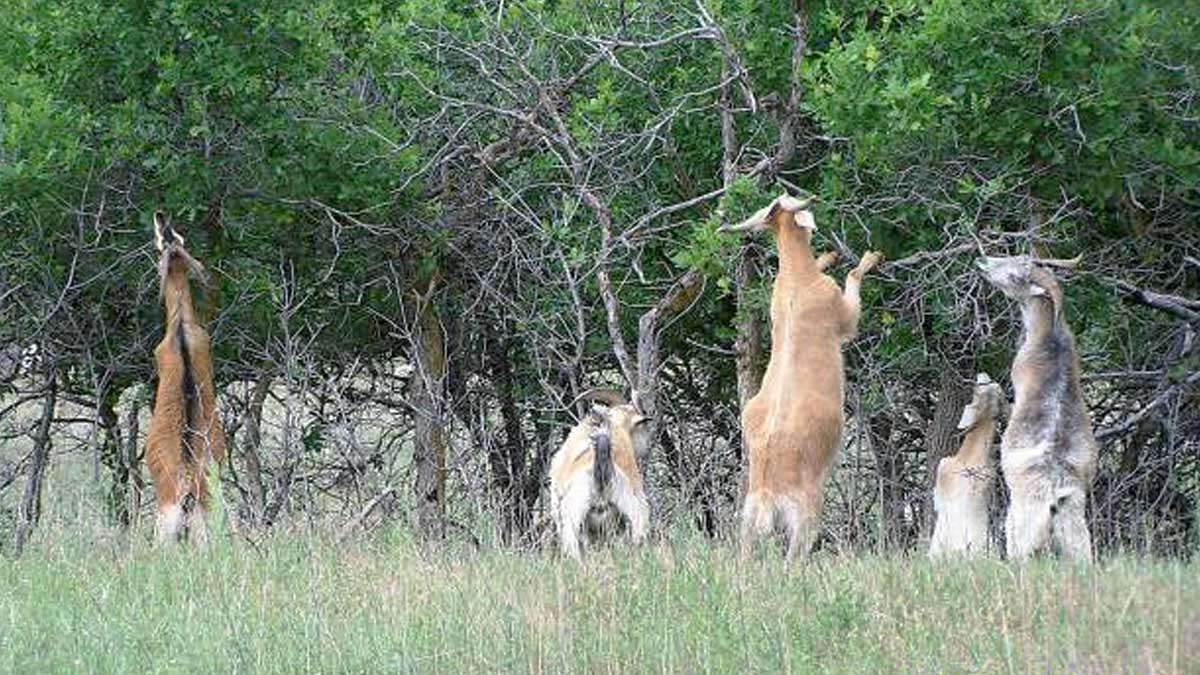
Originally posted Jan 5, 2015 By Marty Metzger / Website: https://www.thefencepost.com/news/rancher-and-goats-have-hearty-appetite-for-healthy-environment/
Cattle rancher Lani Malmberg had never seen a goat up close and personal. Now she travels the country with an entourage of many hundreds.
Times got hard on her family’s Wyoming ranch in the 1980s. So the single mom raising two sons worked even harder, eventually meriting a degree in environmental restoration and biology botany from Mesa State College in Grand Junction, Colo. Following graduate school in 1997, then 39-year-old Malmberg attended a seminar at which a woman told her about some Cashmere goats she had just bought.
Malmberg’s interest was piqued and she was convinced these were the animals for her. She had been seeking a way to naturally control unwanted weeds while reclaiming and healing damaged soils. So, she and her two sons invested every dime they had in a dispersal herd of 100 heads in Kiowa.
Cashmere goats differ from other goat breeds in that their demeanor is extremely polite, Malmberg said. Working with them is usually uneventful because they calmly load into her semi-trailer and respect electric fencing. They are okay with all drinking water types, and they are not overly gentle, like dairy goats that prefer being pets. Boers are not as nimble, athletic, or respectful, Malmberg said.
She adamantly repeated that she is not in production agriculture. She leaves her well-mannered goats lean and healthy. They are not meat animals. They are not her pets either, but so much more, she said. They are really loyal, lifelong employees that do not demand perks.
Malmberg, her goats, and five Border Collies are always on the move, traveling from one contract job to the next. She said she gets paid every day of the year with a herd of grazing animals.
“Everything I own has four legs or four wheels, and we roll!” Malmberg said.
The 57-year-old does not own or rent any domicile but instead lives in a camper. Her perpetual nomadic lifestyle likewise does not allow for “vacations”. Certainly, no resort would accommodate 1,000 goats and five working dogs, she joked. But she does visit friends across the country as she goes. What could be better?
Well, she believes what is better is what she, her son Donny Benz and their animals do for the environment. Malmberg travels with one herd, Donny with another. Son Reggie Benz assists as needed. They seek not to artificially eradicate certain species, but rather to replace them with those more beneficial for a particular setting.
Malmberg’s business, “Goat Green,” truly operates by its mission statement: “To provide landowners an alternative to chemical and mechanical methods for land stewardship, using managed goat grazing to build a living, functioning ecosystem, where desired plants sustain each other with balanced, recycling microbes in the nutrient-rich soil and water, is held in situ.”
Clients contact her to rid their property of unwanted plants. Leafy spurge, for example, is an accidentally imported, pest species with no natural enemies in the United States. But think of it like candy for goats. Malmberg said they love it.
Some of those clients have included city, county, state, and federal government agencies, homeowners’ associations, private landowners, and oil/gas companies required to perform land reclamation.
On a typical job, she first seeds the Cashmere’s imminent grazing land with a broadleaf such as a clover or herbs. Then the herd goes to work, directed and supervised by Malmberg’s five Border Collies, ages one through 11. Malmberg acknowledged the dogs are “key to the operation and run the whole show.”
“They’re an extension of my heart, spirit, and soul, much more than pets,” said Malmberg in a tone of admiration more than mere sentimentality.
So how do goats alter the landscape? Their narrow, pointed mouths and lateral jaw movement crush and destroy weeds and their seeds, Malmberg said. A herd of 400 goats eats approximately 2,000 pounds of weeds per day and, amazingly, no viable weed seed remains after passing through the ruminants’ four stomachs containing unique enzymes and bacteria.
Unlike grazers such as cows, horses, and elk that prefer grasses, goats are browsers that gleefully belly up to a buffet of brush, cactus, poisonous plants, trees, dried leaves, etc. Goats’ least favorite menu item is grass. Not only are they perfect, complementary diet opposites to cattle and horses, Malmberg said, but the two vegetation-eating types are dead-end hosts to one anothers’ parasites.
Benefits of using goats for weed control
Malmberg listed 12 simultaneous steps goats perform, as opposed to only one by mowing:
- Recycling nutrients: Dried vegetation is a combination of carbon, nitrogen, sulfur, calcium, magnesium, boron, phosphorus, manganese, and more.
- Fertilization.
- Irrigation: A 400-head herd of goats drinks and expel it a pint at a time, with a dab of nitrogen added in.
- Soil aeration: Four hundred goats equal 1,600 hooves.
- Trampling fertilizer and moisture into the soil.
- Mulching soil: Dried, uneaten, trampled vegetation protects the soil surface.
- Erosion mitigation: Goats build organic matter that retains water through manure and hoof action. Hoof action further smooths the surface thereby mitigating erosion trails.
- Seedbed preparation for dormant seeds in the system.
- Seedbed packing.
- 1roviding living energy to a stagnant system: A 400-head goat herd is 50,000 pounds of moving, running, playing, eating, pooping, peeing, sleeping animals full of living energy.
- Packing roadbed, smoothing edges, preventing run-off/erosion on road cuts.
- Fire mitigation: Goats eat fire tinder and recycle it all in place.
A bonus is that goats are self-propelled and their very affordable fuel is all undesirable plant species.
Anyone desiring more information on Goat Green should visit www.goatseatweeds.com or email Lani Malmberg at ewe4icbenz@aol.com.
